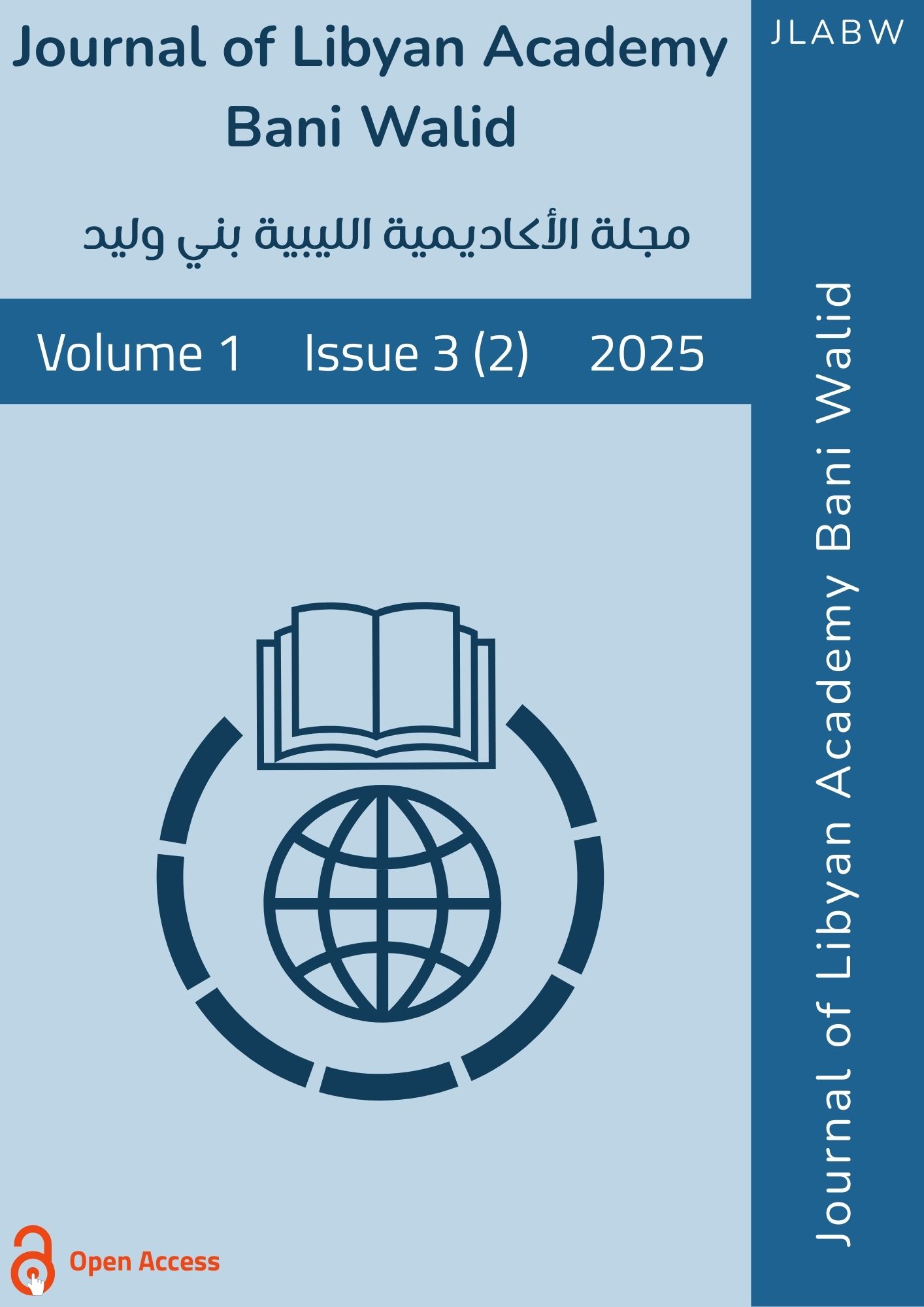تحديد العلاقة بين بعض العناصر البيوكيميائية وهرمون الإستراديول لدى النساء في مرحلتي الإنجاب وانقطاع الطمث
DOI:
https://doi.org/10.61952/jlabw.v1i3.199الكلمات المفتاحية:
الكالسيوم، المغنيسيوم، الإستراديول، الخصوبة، انقطاع الطمث.الملخص
أُجريت هذه الدراسة لتقدير تركيز كل من المغنيسيوم والكالسيوم في المصل وهرمون الإستراديول، وبيان تأثير نقصها لدى النساء في مرحلة انقطاع الطمث مقارنةً بالنساء في مرحلة الخصوبة، وكذلك لتحديد العلاقة بين الفئات العمرية لكل مجموعة مع مستويات المغنيسيوم والكالسيوم والإستراديول.
تم جمع (60) عينة قُسِّمت إلى مجموعتين: الأولى لنساء في سن الإنجاب (30 عينة من فئات عمرية مختلفة)، والثانية لنساء في مرحلة انقطاع الطمث (30 عينة من فئات عمرية مختلفة)، من النساء المراجعات لمختبر الدقة ومختبر الجزيرة ومستشفى مسلاتة.
استُخدم البرنامج الإحصائي SPSS (Statistical Package for Social Sciences) لتحليل البيانات، حيث تم حساب المتوسط الحسابي والانحراف المعياري للمتغيرات قيد الدراسة، كما استُخدمت الطرق الوصفية والتحليلية عبر اختبار T-test لمقارنة المجموعتين (العينات المستقلة) واختبار Levene’s test لتحديد التجانس داخل مجتمع الدراسة، بهدف معرفة الفروق بين مجموعتي الخصوبة وانقطاع الطمث، والتحقق من فروض الدراسة عند مستوى دلالة (P > 0.05).
أظهرت النتائج وجود فروق ذات دلالة إحصائية بين مجموعتي الخصوبة وانقطاع الطمث في كل من المغنيسيوم والكالسيوم، وكانت لصالح مجموعة الخصوبة. كما وُجدت فروق معنوية في مستوى هرمون الإستراديول بين المجموعتين أيضًا لصالح مجموعة الخصوبة.
ومن خلال هذه النتائج تبين أن كلًّا من المغنيسيوم والكالسيوم والإستراديول تكون مستوياتها ضمن المعدلات الطبيعية لدى النساء في سن الإنجاب، بينما تنخفض بشكل ملحوظ لدى النساء في مرحلة انقطاع الطمث.
المراجع
Abdulaziz, H. M. Y., Al-Khudari, L. M. I., & Suleiman, I. R. (2016). The relationship between the quality of life and the severity of menopausal symptoms. Department of Economics for My Home, Faculty of Shatibi Agriculture, Alexandria University. Alexandria Journal of Scientific Exchange, 37(4).
Al-Qamati, A. A.-M. (2005). Endocrine. New United Book House, Beirut, Lebanon.
Al-Qamati, A. A.-M. (2025). Endocrine glands. United New Book House, Beirut, Lebanon.
Baker, S. B., & Worthley, L. I. G. (2002). The essentials of calcium, magnesium and phosphate metabolism. Critical Care and Resuscitation, 4, 301–306.
Bednarek, G. B., Jodkowska, J., & Juchniewicz, J. A. (2010). Zinc, copper, manganese, and selenium status in pre- and postmenopausal women during sex hormone therapy. Advances in Clinical and Experimental Medicine, 19, 337–345.
Bolaji, L., & Kruger, M. (2020). Nutrient and dietary patterns in relation to the pathogenesis of postmenopausal osteoporosis – A literature review. Life, 10, 220. https://doi.org/10.3390/life10090220
Bonte, D., Lighezan, R., Sfrijan, F., David, D., & Zosin, I. (2000). Importance of determination of bone alkaline phosphatase in postmenopausal osteoporosis. Annals of RSCB, 15, 234–241.
Ciosek, K., Kot, D., Kosik-Bogacka, D., & Łanocha-Arendarczyk, N. (2021). The effects of calcium, magnesium, phosphorus, fluoride, and lead on bone tissue. Biomolecules, 11(4), 506. https://doi.org/10.3390/biom11040506
Indumati, V., Vidya, S. P., & Jailkhani, R. (2007). Hospital-based preliminary study on osteoporosis in postmenopausal women. Journal of Clinical Biochemistry, 22, 96–100.
Lee, B.-K., & Kim, Y. (2012). Association between bone mineral density and blood lead level in menopausal women: Analysis of Korean National Health and Nutrition Examination Survey 2008–2009 data. Environmental Research, 115, 59–65.
Mahdavi-Roshan, M. (2015). Copper, magnesium, zinc and calcium status in osteopenic and osteoporotic post-menopausal women. Clinical Cases in Mineral and Bone Metabolism, 12, 18–21. https://doi.org/10.11138/ccmbm/2015.12.1.018
Mazouz, A., Toumiat, R., & Lajawi, A. (2020). Contribution to the study of polycystic ovary syndrome. University of Larbi Ben M’hidi, Algeria.
Mendola, P., Messer, L. C., & Rappazzo, K. (2008). Science linking environmental contaminant exposures with fertility and reproductive health impacts in the adult female. Fertility and Sterility, 89, e81–e94. https://doi.org/10.1016/j.fertnstert.2007.12.039
Nagata, C., Takatsuka, N., Inaba, S., Kawakami, N., & Shimizu, H. (1998). Association of diet and other lifestyle with onset of menopause in Japanese women. Maturitas, 29, 105–113. https://doi.org/10.1016/S0378-5122(98)00007-0
Odabasi, E., Turan, M., Aydin, A., Akay, C., & Kutlu, M. (2008). Magnesium, zinc, copper, manganese, and selenium levels in postmenopausal women with osteoporosis: Can magnesium play a key role in osteoporosis? Annals of the Academy of Medicine Singapore, 37, 564–567.
Omran, I. G., & Ajeel, S. H. (2016). Poise and some rare elements among postmenopausal women. Babylon University Journal of Pure and Applied Sciences, 24(1).
Riggs, B. L., Khosla, S., & Melton, J. L. (1998). A unitary model for involutional osteoporosis: Estrogen deficiency causes both type I and type II osteoporosis in postmenopausal women and contributes to bone loss in aging men. Journal of Bone and Mineral Research, 13, 763–773. https://doi.org/10.1359/jbmr.1998.13.5.763
Santoro, N., Roeca, C., Peters, B. A., & Neal-Perry, G. (2021). The menopause transition: Signs, symptoms, and management options. Journal of Clinical Endocrinology & Metabolism. https://doi.org/10.1210/clinem/dgaa113
Sokoll, L. J., & Dawson-Hughes, B. (1989). Effect of menopause and aging on serum total and ionized calcium and protein concentrations. Calcified Tissue International, 44, 181–185. https://doi.org/10.1007/BF02556322
Strause, L., Saltman, P., Smith, K. T., Bracker, M., & Andon, M. B. (1994). Spinal bone loss in postmenopausal women supplemented with calcium and trace minerals. Journal of Nutrition, 124, 1060–1064. https://doi.org/10.1093/jn/124.7.1060
Tomasz, M.-K., Kuć, A., Kubik-Machura, D., Kościelecka, K., & Radko, L. (2023). Interaction of metals, menopause and COVID-19—A review of the literature. Biology, 12, 350. https://doi.org/10.3390/biology12030350
Wood, R. J. (1994). Potassium bicarbonate supplementation and calcium metabolism in postmenopausal women. Nutrition Reviews, 52(1), 278–280. https://doi.org/10.1111/j.1753-4887.1994.tb01333.x






